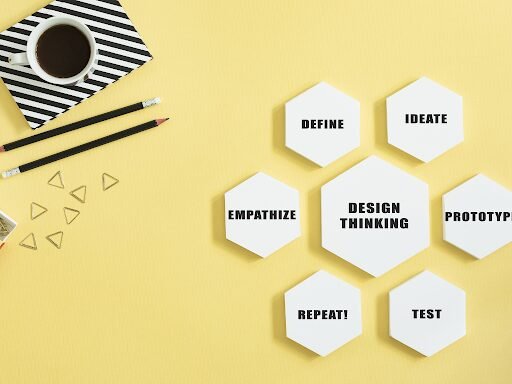The Constitution of India, drafted in the tumultuous aftermath of partition and colonial rule, stands as a testament to the vision and foresight of its framers. This document, with its emphasis on fundamental rights, federalism, and social justice, has served as the bedrock of Indian democracy for over seven decades. However, in a world characterized by rapid societal shifts and complex challenges, questions arise regarding the enduring relevance of the Constitution and the methods used to interpret and implement its principles. This is where the concept of “design thinking” offers a valuable framework for approaching the Constitution in a dynamic and human-centered manner.
In this blog, we will cover the following:
- What is design thinking (DT)?
- Design Thinking and the Constitution: A Framework for Relevance
- Benefits of Applying Design Thinking
- Challenges and Limitations of Using DT for the Constitution
Let’s get straight to it!
What is Design Thinking?
Design thinking is an iterative problem-solving methodology that emphasizes user-centeredness, empathy, and creative problem-solving. It revolves around five key stages:
- Empathize: Deeply understanding the needs, challenges, and aspirations of stakeholders through observation, interviews, and research.
- Define: Identifying the core problem or opportunity based on the insights gathered from the empathize stage.
- Ideate: Brainstorming and generating a multitude of potential solutions to the defined problem.
- Prototype: Creating low-fidelity, tangible representations of these solutions to test and gather feedback.
- Test: Iteratively refining the prototypes based on user feedback and implementing the final solution.
Design Thinking and the Constitution: A Framework for Relevance
Applying design thinking to the constitution can be understood as a continuous process aimed at ensuring its principles and provisions remain relevant and impactful in a changing world. Here’s how each stage of design thinking can be applied:

- Empathize: Understanding the Needs and Challenges
This stage involves understanding the needs and challenges faced by various stakeholders who interact with the constitution. This includes:
- Citizens: Analyzing their concerns regarding access to justice, protection of rights, and participation in governance.
- Government: Assessing their challenges in implementing constitutional principles effectively and efficiently.
- Judiciary: Evaluating the challenges faced in interpreting and applying the constitution in the context of evolving social and technological realities.
- Define: Identifying the Core Issues
Based on the insights gathered from the empathize stage, key areas needing attention can be identified. These might include:
- Gaps in implementation: Instances where constitutional provisions are not adequately implemented, leading to inequalities or injustices.
- Emerging challenges not explicitly addressed: New social and technological realities not foreseen by the framers, requiring creative interpretations and potential amendments.
- Public awareness and understanding: Recognizing the need to enhance public understanding of the Constitution and its relevance in their lives.
- Ideate: Generating Creative Solutions
Here, diverse stakeholders come together to brainstorm potential solutions to the identified issues. This can involve:
- Policy innovations: Developing innovative governance approaches to ensure the effective implementation of constitutional principles.
- Constitutional interpretations: Proposing nuanced interpretations of the constitution in the context of emerging challenges.
- Public engagement initiatives: Creating innovative ways to educate and engage citizens with the constitution.
- Prototype: Experimenting with Solutions
This stage involves developing tangible prototypes, such as pilot programs, legal frameworks, or public awareness campaigns, to test the viability of proposed solutions. These prototypes can be readily implemented on a small scale to understand their effectiveness and gather feedback.
- Test: Evaluating and Refining
Through feedback from stakeholders and analysis of the prototypes’ impact, solutions are refined and iterated upon. This continuous cycle ensures that the constitution remains adaptable and continues to serve its intended purpose in the ever-evolving social landscape.
Benefits of Applying Design Thinking to the Constitution of India
Design thinking, a human-centered approach to problem-solving, could offer some interesting benefits if applied to the Constitution of India. Here are a few potential advantages:

- Identifying Needs of the People: The core of design thinking is understanding user needs. This could involve citizen engagement exercises to identify areas where the Constitution feels outdated or isn’t meeting the needs of a modern India.
- Fostering Inclusivity: Design thinking emphasizes diverse perspectives. This could be used to ensure the Constitution reflects the voices of various communities and social groups within India.
- Simplifying Complex Issues: The Indian Constitution is a vast document. Design thinking tools could help visualize complex legal concepts and make them more understandable for the average citizen.
- Prioritizing Clarity and Efficiency: Design thinking focuses on clear communication and streamlined processes. This could be applied to review legal procedures and ensure they are efficient and accessible.
Challenges and Limitations
While applying design thinking to framing the Constitution of India, the following challenges need to be kept in mind:
- The Constitution’s Sacred Status: The Indian Constitution is a revered document with historical significance. Any attempt to modify it may be seen as disrespectful or attempting to rewrite history.
- The Difficulty of Amending the Constitution: Changing the Constitution requires a complex process with a high bar for approval. One would need to deliver solutions that can easily navigate this hurdle.
- Balancing Ideals with Practicality: The Constitution enshrines fundamental principles. Design thinking might prioritize practicality over these ideals, raising concerns about maintaining the core values of the document.
Overall, design thinking offers a fresh perspective for reviewing the Constitution. However, it should be seen as a tool for understanding citizen needs and informing potential amendments, not a method for a complete overhaul.
Design thinking is a powerful tool for tackling complex issues, but it’s important to recognize its limitations when applied to a document like the Indian Constitution. Here are some additional challenges to consider:
- Scope and Scale: The Constitution sets the foundation for a nation of over 1.3 billion people with immense diversity. Addressing the multifaceted needs of Indian society through the design thinking framework could be overwhelming.
- Historical Context: The Constitution is a product of its time, reflecting the historical circumstances of India’s independence. Design thinking emphasizes rapid prototyping and iteration, which might not be suitable for established legal principles with historical weight.
- Balancing User Needs: Design thinking prioritizes user needs. However, the Constitution needs to consider not just the needs of the current population but also those of future generations. Balancing these sometimes-conflicting needs can be tricky.
- Level of Consensus: Amending the Constitution requires a high degree of consensus among diverse political parties and social groups. Design thinking thrives on user feedback and co-creation, but achieving such a level of agreement on a national scale for fundamental legal principles can be a monumental task.
- Legal Nuance: The Constitution is a legal document with far-reaching consequences. Design thinking’s focus on user-friendliness might not translate well to the complexities and precision required in legal language.
Despite these challenges, design thinking principles like user-centricity and empathy can still be valuable when considering specific amendments or interpretations of the Constitution. However, it’s important to acknowledge that it may not be the ideal framework for a complete overhaul of such a foundational document.
Conclusion:
In conclusion, design thinking can be a valuable tool for upholding the ideals of the Indian Constitution. By incorporating empathy, user-centricity, and iterative improvement, policymakers can create solutions that better serve the needs of all citizens. This can lead to a more inclusive and prosperous India, as envisioned by the Constitution.
About the author
A Haryanvi by origin, an entrepreneur at heart, and a consultant by choice, that’s how Ajay likes to introduce himself! Ajay is the Founding Partner at Humane Design and Innovation Consulting (HDI). Before embarking on HDI, Ajay established the Design Thinking and Innovation practice at KPMG India, laying the foundation for his later venture. His 16+ years of professional career spans various roles in product and service design, conducting strategy workshops, storytelling, and enabling an innovation culture. He has coached 50+ organizations and 2000+ professionals in institutionalizing design and innovation practices. He loves to blog and speak on topics related to Design Thinking, Innovation, Creativity, Storytelling, Customer Experience, and Entrepreneurship. Ajay is passionate about learning, writing poems, and visualizing future trends!
We at Humane Design strongly believe in the human ethos and draw inspiration from humans and other elements of nature to design innovative solutions for organizations of all sizes. We will be glad to be your success partner. Email us your requirements at explore@humaned.in.Connect with Us!



